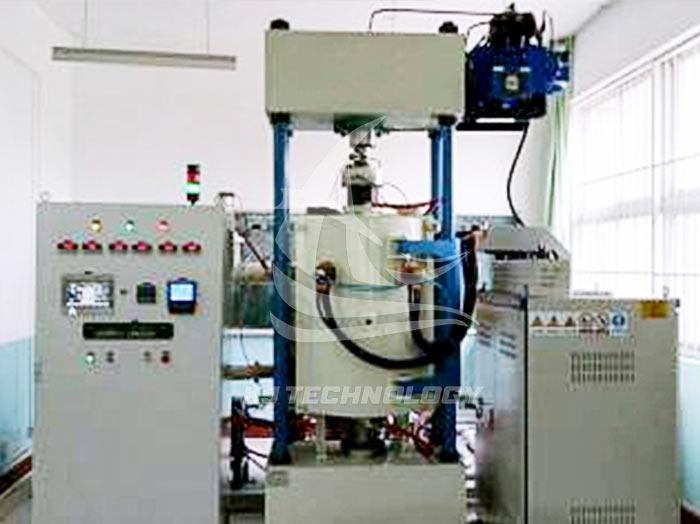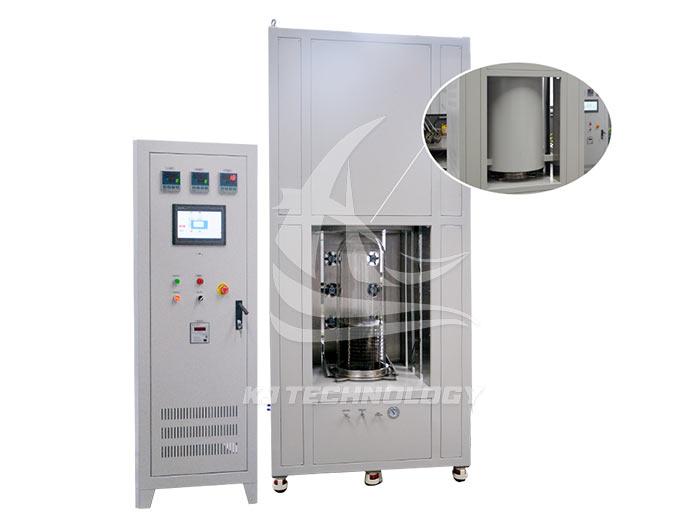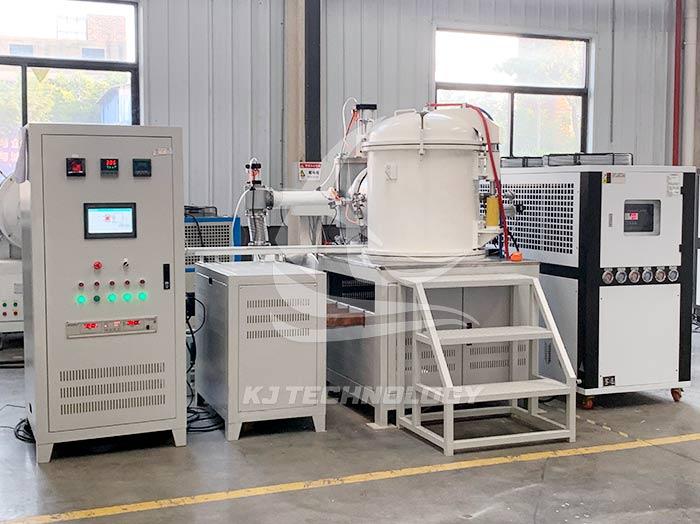Gas vacuum furnace
 07-29-2025 Author: KJ technology
07-29-2025 Author: KJ technology
Gas vacuum furnace (vacuum atmosphere furnace) is an industrial equipment that combines vacuum technology with controlled atmosphere heat treatment. It achieves high-precision heat treatment of materials by creating a vacuum or specific gas environment (such as inert gas, hydrogen, etc.) inside the furnace chamber.
1. Core working principle
Construction of Vacuum Environment
By using vacuum pump systems such as mechanical pumps and molecular pumps, the pressure inside the furnace is reduced to a low vacuum (10 ⁻³ Pa) to a high vacuum (10 ⁻⁶ Pa) range, eliminating harmful gases such as oxygen and water vapor, and preventing material oxidation or decarburization.
atmosphere control
Inert gases such as nitrogen and argon can be filled to protect materials, or hydrogen can be introduced for reduction reactions (such as removing metal oxides), and even surface treatment processes such as carburizing and nitriding can be achieved through mixed gases.
Heating and cooling
Heating: Resistance heating (such as molybdenum wire, graphite heating element) or induction heating is used, and the temperature uniformity can reach ± 1-5 ℃, with a maximum temperature of over 1800 ℃.
Cooling: Supports gas quenching (high-pressure inert gas rapid cooling) or oil quenching to meet the cooling rate requirements of different materials.
2. Key technological advantages
Non oxidizing environment
Vacuum or inert gas protection can prevent surface oxidation of materials, significantly improve surface quality, and reduce subsequent processing costs.
Accurate temperature control
Equipped with a PID temperature control system, the temperature fluctuation is ≤ ± 1 ℃, ensuring the repeatability and stability of the heat treatment process.
Uniform heating
Radiation heating is the main method, combined with convection fans (filled with gas) to improve the heating uniformity of complex geometric workpieces and reduce thermal stress.
Energy saving and efficient
High quality insulation materials (such as polycrystalline alumina fibers) and double-layer water-cooled structure reduce heat loss and energy consumption by more than 30% compared to traditional furnaces.
Multi functional process support
Vacuum sintering: used for densification of materials such as hard alloys and ceramics.
Vacuum brazing: achieving non oxidative bonding of materials such as high-temperature alloys and titanium alloys.
Vacuum annealing/tempering: eliminates internal stress in materials and improves mechanical properties.
Atmosphere treatment: Supports surface strengthening processes such as carburizing, nitriding, and carbonitriding.
3. Typical application areas
Metallic materials
Aerospace: Heat treatment of high-temperature alloys and titanium alloys to meet the requirements of extreme environmental use.
Automotive industry: quenching and tempering of mold steel and high-speed steel to improve wear resistance and service life.
Electronic industry: Non oxidation treatment of semiconductor devices and electronic component packaging to ensure high purity.
powder metallurgy
Sintering and infiltration of metal powders to prepare high-performance alloys and composite materials.
Vacuum sintering of hard alloys (such as tungsten cobalt alloys) reduces cobalt volatilization and increases density.
ceramic materials
The sintering of transparent alumina ceramics and silicon nitride ceramics avoids oxidation and improves transparency.
Brazing of ceramics and metals to achieve the connection of dissimilar materials.
New material research and development
Synthesis and characterization of high-temperature superconducting materials and nanomaterials.
Sintering of magnetic materials (such as neodymium iron boron) to optimize magnetic properties.
4. Selection of core parameters
Temperature range and uniformity
Select the upper temperature limit based on material characteristics (such as 1200 ℃, 1600 ℃, 1800 ℃), and confirm the temperature uniformity index inside the furnace.
Furnace size and structure
The inner diameter and length of the furnace should be adapted to the sample size to ensure uniform heating.
Multi temperature zone design can optimize temperature gradient control in complex processes.
Vacuum system configuration
Extreme vacuum degree (such as 10 ⁻⁵ Pa) and pumping rate affect process efficiency.
The partial pressure system supports precise control of gas flow and pressure to meet the requirements of processes such as carburizing.
Atmosphere control ability
The multi gas supply system supports the adjustment of mixed gas ratios.
Mass flow meters (MFCs) ensure gas flow accuracy of ± 1% FS.
Safety and usability
Equipped with safety devices such as over temperature alarm, leakage protection, emergency stop, etc.
Touch screen control supports remote monitoring and data recording, simplifying the operation process.
5. Industry application cases
In the aerospace field, a certain enterprise uses a vacuum furnace to heat treat titanium alloy blades, reducing the thickness of the surface oxide layer from the traditional process of 5 μ m to 0.5 μ m and increasing the fatigue life by 40%.
Semiconductor manufacturing: A chip manufacturer uses a vacuum furnace for transistor annealing, and by precisely controlling the hydrogen partial pressure, the oxygen content is reduced from 50ppm to 5ppm, significantly reducing leakage current.
Powder metallurgy industry: A certain hard alloy manufacturer adopts vacuum sintering technology, which reduces the porosity of the product from 0.8% to 0.2% and increases the bending strength by 25%.








